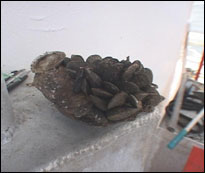The way he tells the story, the shrimp gave just the first sign that Caernarvon was changing his world. Then, something strange started happening to his oysters. Barisich and his family had been producing oysters in this area for years. Fishermen like Barisich leased thousands of acres—from the state government— on the bottom of the bay, and they built oyster farms.
"These were the best things that's on the market," asserts Barisich. "I mean you could stack these against any other oyster, any part of the country, and they was always in demand."
But suddenly, a plague of killer mussels swarmed into the bay. You can't eat this kind of mussel—they're a nuisance. They attach to the oyster shells.
| |

Mussels choke out the native oyster population Photo: William Brangham/NOW with Bill Moyers |
Within three years, his oysters were worthless. State studies suggest that it was mainly because of Caernarvon. When the government unleashed the Mississippi and sent river-water and mud gushing into this area, they lowered the salt content of the bay. Those changes were good for the marsh, but they pushed out the shrimp that like salty environments, and they attracted the killer mussels that don't.
"And that's what gets fisherman hot. It would be just like if you had a piece of property and you farmed tomatoes on it and they wanted to build an interstate," explains Barisich. "And they just took it and said, 'Too bad!'"
A $14 Billion Project
Fishermen aren't the only ones who say projects like Caernarvon can backfire. A few scientists are worrying, too. State and federal officials are planning to ask Congress to launch a massive project to help rescue the wetlands: they want to build more projects like Caernarvon, bigger projects like Caernarvon, up and down the Mississippi River. The group figures they'll need at least $14 billion to start, and one government official told me the project could cost two or three times that much. But a few voices are saying 'Not so fast.'
"I do not believe that we are ready to scale to a $14 billion effort at this time," says Joe Suhayda, who just retired as director of a water research center at Louisiana State University. Suhayda says Louisiana's wetlands are a national treasure, and the country should urgently try to protect them. But he says construction projects like Caernarvon won't work magic, no matter how much money they cost. The damage in the wetlands is too vast.
Suhayda explains, "I was in fact talking with the governor, and he actually asked a question, 'Can we actually save the coast?' 'No, ' I said, from the standpoint of returning it to a former condition, I don't think we can save the coast. There'll be small areas that may be improved."
And Suhayda says they need more studies to pinpoint which areas could improve, and which strategies will work best. Nobody's ever tried to restore nature on such a massive scale.
In Louisiana, this is not a popular view. The state's leaders say it's going to be hard enough to convince Congress to spend billions on wetlands when they're scrounging for money to fight terrorists. The last thing they need is dissent. Suhayda says some of his colleagues have warned him to back off.
"The phrase that's been used is that 'you're too honest,'" says Suhayda. "I've not really had anybody say, 'Don't say this,' but I have had people say that in the wrong light, the things that you say could hurt the effort that everybody thinks should go forward."
Back in the wetlands, Denise Reed is tromping through the new mud and grasses that she says Caernarvon helped create. She and most other researchers say there's no time left for doubts. The country has to do something dramatic, to try to save wetlands, now.
"We can't wait another ten years," says Reed. "There won't be much marsh left to save. We can't afford to go slower. The problem is so serious that action is clearly needed. This isn't just about marshes, it's about the future of coastal Louisiana."
She says it's true, scientists don't know yet exactly how they'll do it; they'll learn from projects like Caernarvon as they go along. Reed says everybody should have learned something from all those centuries of battling the Mississippi River. There's no quick fix when you try to fix nature.
Next: Some Win, Some Lose

